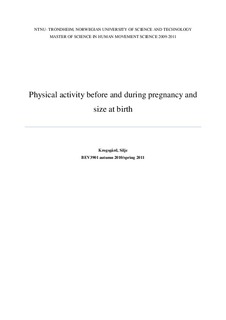| dc.description.abstract | Background: Newborn macrosomia is related to a range of serious health outcomes for both the baby and the mother. Maternal lifestyle factors, including physical activity and body mass index, may influence the final birth weight of the baby; however, the existing literature shows inconsistent results. The objective of the present investigation was to assess the relation of physical activity measured either before or during pregnancy with birth weight, and more specifically, to examine the effect of physical activity on the risk of delivering a high birth weight infant. In addition, we will explore the combined effect of body mass index (BMI) and leisure time physical activity (LTPA) in relation to birth weight and risk of macrosomia (defined as birth weight ≥4,000 g).
Methods: We used data from two large health surveys conducted in 1984-1986 (HUNT I) and 1995-1997 (HUNT 2) in Nord- Trøndelag county, Norway. The study included 2,277 women in HUNT 1 and 2,286 women in HUNT 2 aged 20-39 years, who gave birth to at least one child during a five year period after participation. LTPA was assessed by baseline questionnaires, maternal BMI was computed from measured height and weight, and a linkage to the Medical Birth Registry of Norway provided data on newborn birth weight. In linear regression, adjusted differences in mean birth weight were calculated, and logistic regression was used to compute odds ratios (ORs) with 95% confidence interval (CI) for macrosomia.
Results: No clear association was found between the different measures of LTPA before or during pregnancy with birth weight in any of the surveys. However, women who were inactive before pregnancy in HUNT 1 had about 40% lower risk for having an offspring with macrosomia, compared with women who had a high level of LTPA (OR, 0.59; CI, 0.4-0.9). In additional analysis, the combined effect of maternal pre- pregnancy BMI and LTPA before pregnancy showed that overweight women (BMI ≥25.0 kg/m2) who reported no or low LTPA in HUNT 1 gave birth to offspring with significantly higher birth weight (134 g, CI, 41.0-227.3 g) and had an OR for macrosomia of 1.87 (CI, 1.2-2.9) compared to women with BMI <25.0 kg/m2 who were more active. In HUNT 2, overweight women, across all categories of LTPA, gave birth to offspring with significantly higher birth weight than women with BMI <25.0 kg/m2, and they had also a higher odds ratio for macrosomia.
Conclusion: No clear association was found between the different measures of LTPA before or during pregnancy with birth weight. However, the result may indicate that inactive women may give birth to infants with lower birth weight and have decreased risk for delivering an infant with high birth weight. Maternal pre- pregnancy BMI may be a more important determinant of birth weight. The combined effect of maternal BMI and LTPA in relation to birth weight should be considered in future studies. | nb_NO |
